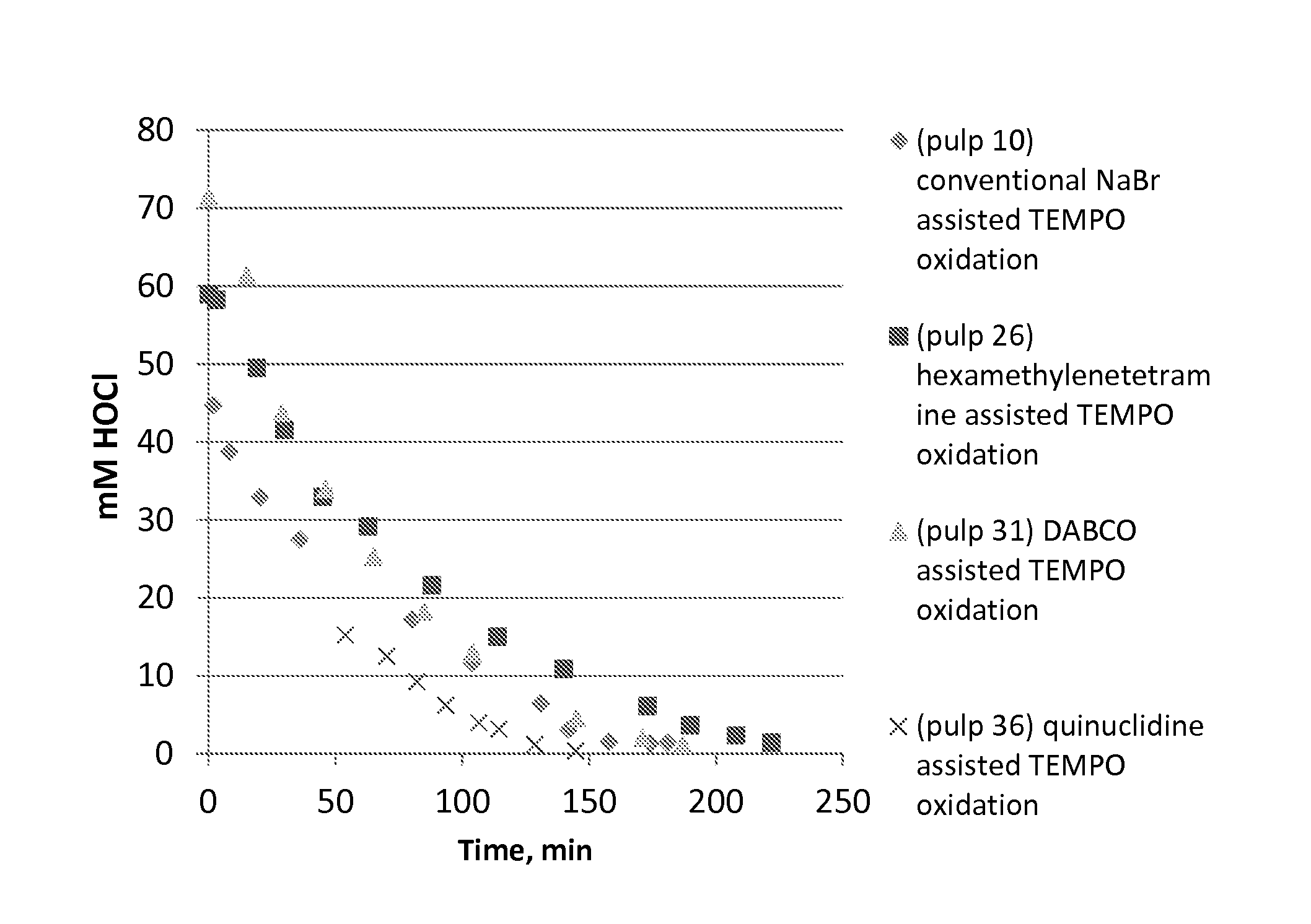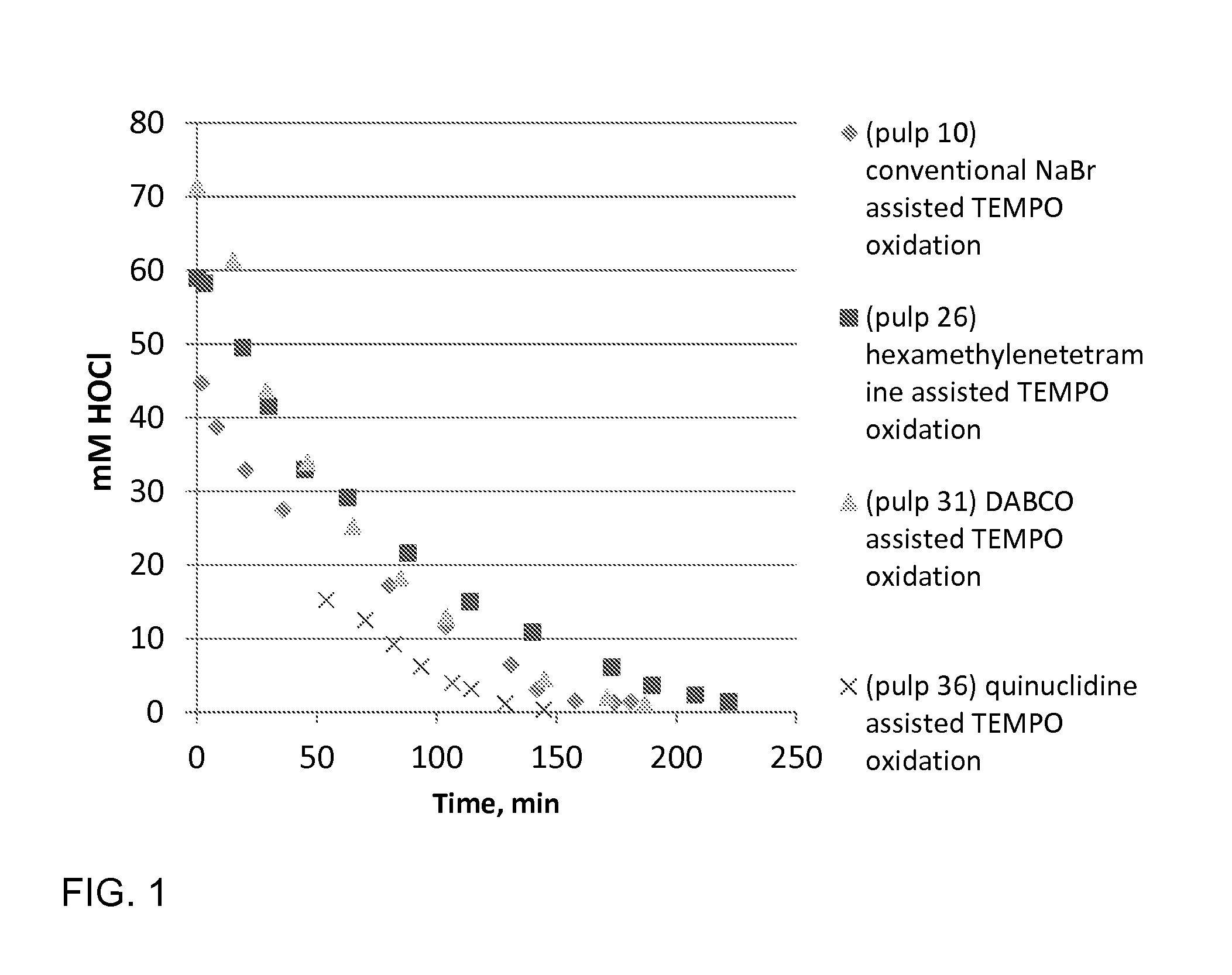Method for catalytic oxidation of cellulose and method for making a cellulose product
a technology of cellulose and catalytic oxidation, which is applied in the field of catalytic oxidation of cellulose, can solve the problems of difficult to remove bromide residues from the final cellulose product, undesirable use of bromine in industrial scale, and problematic use of bromine compounds in the oxidation reaction, etc., and achieve selectively and effectively oxidizing the c-6 hydroxyl group
- Summary
- Abstract
- Description
- Claims
- Application Information
AI Technical Summary
Benefits of technology
Problems solved by technology
Method used
Image
Examples
first embodiment
Tertiary Amine Activation
Results
[0061]Birch pulp was used in oxidation experiments. Reaction rate was followed by active chlorine titration and oxidation was ready when all NaClO was consumed. The selected pH level as maintained by NaOH, which was added by portions during oxidations. TEMPO oxidation with NaBr (pulp 10) represents the conventional oxidation which is widely reported in literature. TEMPO oxidation with (N(CH3)3) (pulp 5), which is a linear tertiary amine, is slow and unselective. This amine probably fragments easily. The cyclic tertiary (quinuclidine, hexamethylenetetramine, DABCO) amine assisted TEMPO oxidations are more selective and reaction rate is higher compared the oxidation with (N(CH3)3) assisted TEMPO oxidation. The cyclic tertiary amines are more stable. pH 8.5 was optimal level when quinuclidine (pulp 36) was used as activator of TEMPO. Optimal temperature to amine assisted TEMPO oxidations is 35-50° C. according to these experiments. Low amine dosage / dosag...
second embodiment
Chlorine Dioxide Activation
[0066]Materials:
[0067]Bleached birch pulp, TEMPO (Aldrich), ClO2 water solution (prepared in lab), 3.5% NaClO solution (VWR), NaClO2, 1 M NaOH, 1 M HCl, Büchi reactor (volume 1.6 dm3), Metrohm 718 Stat Titrino titrator (pH adjustment), Metrohm 751 GPD Titrino titrator (conductometric titration), Tiamo 1.2.1. software (conductometric titration), Shimadzu 2550 UV-Vis spectrophotometer and UVProbe 2.32 software.
[0068]Oxidation of Bleached Birch Pulp:
[0069]TEMPO was mixed with ClO2 water solution in a closed vessel. Despite low water solubility, TEMPO was dissolving to the solution (color change from red to black) while radical TEMPO was converting to oxidized form. The pulp was mixed with water (pulp consistency 1-4%) and transferred to Büchi reactor (mixing, temperature 25-50° C., volume of pulp solution 1-1.2 dm3). The activated TEMPO solution and NaClO was added to the Büchi reactor. pH was adjusted to 8 by 1 M NaOH and automatic titrator after rapid pH de...
third embodiment
Protection in the Acid Phase
[0090]Following the catalytic oxidation in the first step, which is performed according to the second embodiment (activation of the catalyst by ClO2 and oxidation by hypochlorite as main oxidant), the oxidation of the residual aldehydes by chlorite in the second step is performed using a protective substance which prevents the formation of hypochlorous acid.
[0091]The following is a general description of the two-step process that can be used in the third embodiment.
[0092]The first step (alkaline): TEMPO is dosed into a closed vessel, to which the aqueous chlorine dioxide solution is added. The chlorine dioxide activates the TEMPO to an oxidized form. This can be seen visually: the red TEMPO turns black and dissolves in the aqueous chlorine dioxide solution. The typical ClO2 / TEMPO molar ratio is 1.2. The concentration of chlorine dioxide and NaClO has been titrated on the same day as the oxidation is performed. Preheated water, cellulose and the chlorine d...
PUM
| Property | Measurement | Unit |
|---|---|---|
| temperature | aaaaa | aaaaa |
| pH | aaaaa | aaaaa |
| mean length | aaaaa | aaaaa |
Abstract
Description
Claims
Application Information
 Login to View More
Login to View More - R&D
- Intellectual Property
- Life Sciences
- Materials
- Tech Scout
- Unparalleled Data Quality
- Higher Quality Content
- 60% Fewer Hallucinations
Browse by: Latest US Patents, China's latest patents, Technical Efficacy Thesaurus, Application Domain, Technology Topic, Popular Technical Reports.
© 2025 PatSnap. All rights reserved.Legal|Privacy policy|Modern Slavery Act Transparency Statement|Sitemap|About US| Contact US: help@patsnap.com



